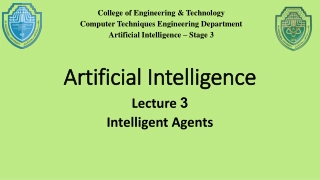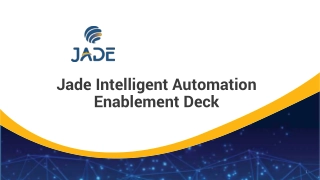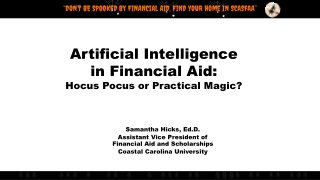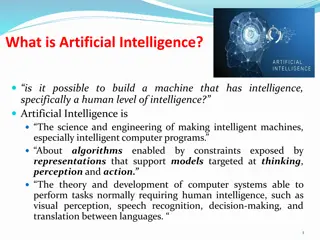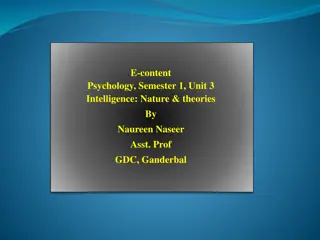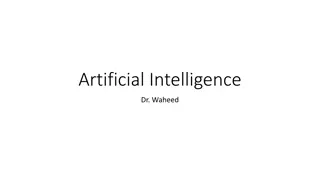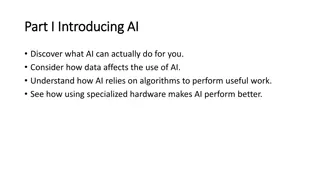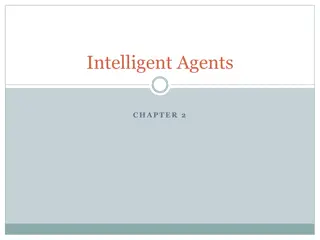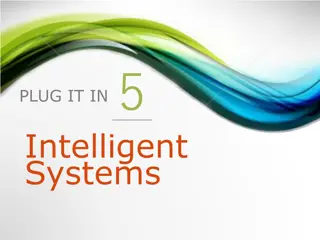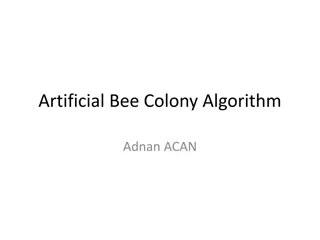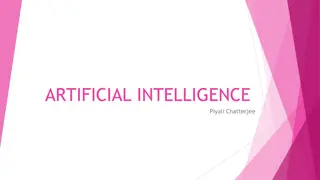Understanding Intelligent Agents in Artificial Intelligence
Intelligent agents in artificial intelligence act rationally to achieve the best outcomes in various environments. They operate autonomously, perceive their surroundings, adapt to changes, and pursue goals efficiently. Developing intelligent agents involves examining agents, environments, and their coupling. A rational agent follows a performance measure to determine the right actions and aims for optimal results. Rationality in agents is influenced by performance measures, prior knowledge, and decision-making processes.
- Intelligent Agents
- Artificial Intelligence
- Rationality
- Performance Measures
- Agent-Environment Interaction
Download Presentation

Please find below an Image/Link to download the presentation.
The content on the website is provided AS IS for your information and personal use only. It may not be sold, licensed, or shared on other websites without obtaining consent from the author. Download presentation by click this link. If you encounter any issues during the download, it is possible that the publisher has removed the file from their server.
E N D
Presentation Transcript
Artificial Intelligence Lecture 3: Intelligent Agent By: Nur Uddin, Ph.D 1
Acting rationally: The rational agent approach An agent is just something that acts (agent comes from the Latin agere, to do). Computer agents are expected to do: operate autonomously, perceive their environment, persist over a prolonged time period, adapt to change, create and pursue goals. A rational agent is one that acts so as to achieve the best outcome or, when there is uncertainty, the best expected outcome. 2
What we are going to do? Use the rational concept to develop a small set of design principles for building successful agents that is called intelligent agent. How to develop intelligent agents? Examining agents Examining environments Examining the coupling between agents and environments 3
Agent and Environments An agent is anything that can be viewed as perceiving its environment through sensors and acting upon that environment through actuators. 4
Agent Function We use the term percept to refer to the agent s perceptual inputs at any given instant. An agent s percept sequence is the complete history of everything the agent has ever perceived. An agent s behaviour is described by the agent function that maps any given percept sequence to an action. Agent function: Table (External) Agent program (Internal) 5
What is the right thing? A rational agent is one that does the right thing conceptually speaking, every entry in the table for the agent function is filled out correctly. When an agent is plunked down in an environment, it generates a sequence of actions according to the percepts it receives. This sequence of actions causes the environment to go through a sequence of states. If the sequence is desirable, then the agent has performed well. A performance measure that evaluates any given sequence of environment states. 7
Rationality Rational depends on four things: The performance measure that defines the criterion of success. The agent s prior knowledge of the environment. The actions that the agent can perform. The agent s percept sequence to date. 9
Definition of a Rational Agent For each possible percept sequence, a rational agent should select an action that is expected to maximize its performance measure, given the evidence provided by the percept sequence and whatever built-in knowledge the agent has. 10
Omniscience An omniscient (maha tahu) agent knows the actual outcome of its actions and can act accordingly; but omniscience is impossible in reality. Consider the following example: I am walking along the Champs Elys ees one day and I see an old friend across the street. There is no traffic nearby and I m not otherwise engaged, so, being rational, I start to cross the street. Meanwhile, at 33,000 feet, a cargo door falls off a passing airliner, and before I make it to the other side of the street I am flattened. Was I irrational to cross the street? It is unlikely that my obituary would read Idiot attempts to cross street. 11
Rational vs Perfection This example shows that rationality is not the same as perfection. Rationality maximizes expected performance, while perfection maximizes actual performance. 12
Omniscience, Learning, and Autonomy Rationality does not require omniscience, then, because the rational choice depends only on the percept sequence to date. A rational agent requires to: Information gathering Learning 13
Learning An agent requires to learn as much as possible from what it perceives. The agent s initial configuration could reflect some prior knowledge of the environment, but as the agent gains experience this may be modified and augmented. There are extreme cases in which the environment is completely known a priori. In such cases, the agent need not perceive or learn; it simply acts correctly. 14
Autonomy A rational agent should be autonomous, it should learn what it can to compensate for partial or incorrect prior knowledge. 15
The Nature of Environments Specifying the task environment PEAS (Performance, Environment, Actuators, Sensors) description 16
Performance Measure Example of performance measure for automated taxi driver: a. getting to the correct destination b. minimizing fuel consumption and wear and tear; c. minimizing the trip time or cost; d. minimizing violations of traffic laws and disturbances to other drivers; e. maximizing safety and passenger comfort; f. Maximizing profits. Obviously, some of these goals conflict, so tradeoffs will be required. 17
Performance Measure (Contd) What is the driving environment that the taxi will face? Any taxi driver must deal with a variety of roads, ranging from rural lanes and urban alleys to 12-lane freeways. The roads contain other traffic, pedestrians, stray animals, road works, police cars, puddles, and potholes. The taxi must also interact with potential and actual passengers 18
The Structure of Agents We have talked about agents by describing behavior the action that is performed after any given sequence of percepts. The job of AI is to design an agent program that implements the agent function the mapping from percepts to actions. We assume this program will run on some sort of computing device with physical sensors and actuators we call this the architecture. agent = architecture + program 20
Agent Program vs Agent Function Agent program takes the current percept as input. Agent function takes the entire percept history. The agent program takes just the current percept as input because nothing more is available from the environment; if the agent s actions need to depend on the entire percept sequence, the agent will have to remember the percepts. 21
Kinds of Agent Program Four basic kinds of agent programs that embody the principles underlying almost all intelligent systems: 1. Simple reflex agents; 2. Model-based reflex agents; 3. Goal-based agents; 4. Utility-based agents. 22


